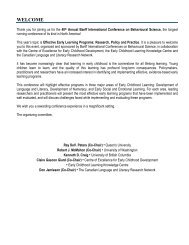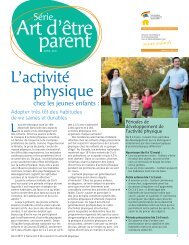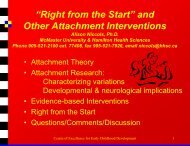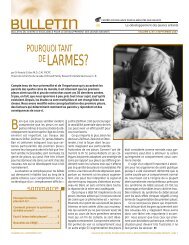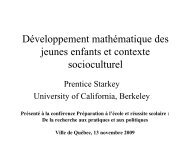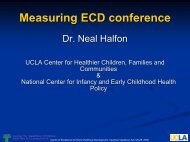Bulletin - The measure of excellence : Canadian early childhood ...
Bulletin - The measure of excellence : Canadian early childhood ...
Bulletin - The measure of excellence : Canadian early childhood ...
You also want an ePaper? Increase the reach of your titles
YUMPU automatically turns print PDFs into web optimized ePapers that Google loves.
SPECIAL FEATURE ON RESEARCH: NEWBORN BABIESNO NEED FOR A BAN: STUDY FINDS PACIFIERSNOT LINKED TO EARLY WEANINGWhether it is called a pacifier, asoother or, as the British do, adummy, this little rubber object hascreated controversy. Studies havesuggested a link between pacifieruse and <strong>early</strong> weaning from breastfeeding,possibly by creating nippleconfusion in the baby.Both the World Heath Organizationand the United NationsChildren's Fund strongly discourageits use, and observational (nonexperimental)studies have consistentlyshown that babies who use pacifierson a daily basis are weaned earlierthan those who do not. Yet studiesalso show that pacifiers reduce ababy's crying in the short term, abenefit for both parents and child.<strong>The</strong>n a team <strong>of</strong> <strong>Canadian</strong> researchersset out to explore what rolethe pacifier might play in weaningand soothing babies. <strong>The</strong>y carriedout a randomized, double-blind,controlled study at Montreal's RoyalVictoria Hospital with 281 mothers(258 completed the study). All thewomen received information andhelp with breastfeeding. However,one group was asked to avoid usinga pacifier when the baby cried orfussed. Instead, mothers were askedto <strong>of</strong>fer the breast or to try carryingor rocking the infant. A secondgroup received information on alloptions available for soothing thebaby from breastfeeding to using apacifier. <strong>The</strong> mothers kept a log <strong>of</strong>their infant's behaviour at four, sixand nine weeks <strong>of</strong> age. <strong>The</strong> motherswere also interviewed at threemonths to assess breastfeeding andpacifier use rates.<strong>The</strong> researchers discovered thatpacifier use, when analyzed accordingto the randomized allocation, had noeffect on the risk <strong>of</strong> weaning bythree months. When randomized allocationwas ignored, however, thosebabies who used pacifiers on a dailybasis were more likely to be weanedby three months. <strong>The</strong>se resultsstrongly suggest that pacifier use is amarker (indicator) <strong>of</strong> breastfeedingdifficulties or a mother's decliningcommitment to breastfeeding, ratherthan a true cause <strong>of</strong> <strong>early</strong> weaning.<strong>The</strong> study also found that thepacifier was no more successful inpacifying the baby than othersoothing methods, such as breastfeeding,carrying and rocking. Thismuch-debated object may provide awarning to health pr<strong>of</strong>essionals <strong>of</strong>Tiny, fragile and vulnerable, babiesborn weighing less than one kilogramneed all the help advancedtechnology can provide. Simply survivingis a struggle, and those wholive <strong>of</strong>ten face a host <strong>of</strong> health anddevelopmental problems. Now, arecent study suggests that theseextremely low-birthweight (ELBW)babies may need monitoring, particularlyfor behavioural problems,well into their school years.Published in <strong>The</strong> Lancet, the studyexamined 408 ELBW children fromheight to ten years <strong>of</strong> age in theNetherlands, Germany, Canada andthe United States. Researchers askedparents to answer questions abouttheir children using a tool called theChild Behavior Checklist. This list helpsidentify behaviours that are aggressive,delinquent,anxious,somatic(suchas dizziness and headaches) or withdrawn,as well as social, thought andpotential breastfeeding difficultiesthat could derail the mother-infantnursing relationship."Understanding that pacifier useis a marker and not a cause <strong>of</strong>breastfeeding difficulties may helphealth pr<strong>of</strong>essionals find newapproaches to helping breastfeedingmothers who are reachingfor the pacifier, and pacifier; when abreastfeeding mother is using asoother, she may need more helpand support," said Dawn Walker,Executive Director <strong>of</strong> the <strong>Canadian</strong>Institute <strong>of</strong> Child Health. WalkerTINY BABIES,LONG-TERM PROBLEMSattention problems.<strong>The</strong> scores for the ELBW childrenwere compared to scores for full-termchildren. In all four countries, the ELBWchildren exhibited greater social,thought and attention difficulties.<strong>The</strong> researchers concluded thatELBW children, regardless <strong>of</strong> the culturethey are born into, are at risk for thoughtproblems, attention difficulties andproblems integrating into social groups.<strong>The</strong>y hold that ELBW children should bemonitored on an ongoing basis andprovided with preventive interventionfor learning and social problems.Chad O'Brien, a regional coordinator<strong>of</strong> Early Childhood for First Nations<strong>of</strong> Quebec and Labrador Health andSocial Services Commission, said thestudy came to some very valid conclusions."Extremelylow-birthweight childrenare definitely at a disadvantage,"he said. However, O'Brien added thatmore research should be done to lookadded that women today feel greatpressure to breastfeed but mayunderestimate the time and effortinvolved. Using a pacifier may beone way to shift a breastfeedingbaby's schedule (normally everyhour and half to two hours) moretowards the three-to-four hourintervals <strong>of</strong> a formula-fed infant.Ref.: M. S. Kramer et al., "PacifierUse, Early Weaning, and Cry/FussBehavior. A Randomized ControlledTrial,” Journal <strong>of</strong> the AmericanMedical Association, vol. 286, July2001.at how socio-economic issues impactthe behavioural problems <strong>of</strong> ELBWchildren. He also noted that the studylooked exclusively at Western andEuropean cultures and suggested itwould be worthwhile to look at othercultures such as First Nations.While the study confirms whatmany practitioners have long suspected,namely that extremely lowbirthweightchildren need long-termcare and follow-up, O'Brien addedthat resources are still few and farbetween. "<strong>The</strong>re is so little out therefor these kids. We need educationand awareness programs. Preventingpreterm birth would also be key. Butwe need to increase the funding forservices to children."Ref.: É. T. M. Hille et al. "BehavioralProblems in Children Who Weigh1000g or Less at Birth in FourCountries." <strong>The</strong> Lancet. Vol. 357. May2001.VOLUME 1, N O 3 - DECEMBER 2002 BULLETIN OF THE CENTRE OF EXCELLENCE FOR EARLY CHILDHOOD DEVELOPMENT - PAGE 9



